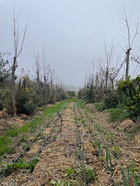
SYNTROLINA
Casalina meets Granola
Starting in 2025, Casalina Embraces Syntropy!
Its first application will be Angela’s cereal project. This young local farmer aims to develop granola production (made from cereals, fruit, and honey) by expanding cultivated areas around the Farm.
Casalina is now pioneering a new agricultural model: the birth of Syntrolina, a resilient farming lab created to support Casalina’s agricultural projects and its network (La Restanza, the local community of farmers).
What is Syntropic Agriculture ?
Syntropy combines permaculture and regenerative agroforestry to merge food production with ecosystem restoration.
It relies on the careful selection and arrangement of diverse plant species, along with specific practices (such as pruning, organic matter recycling, etc.). This maximizes photosynthesis and biomass production.
By developing sustainable, resilient methods, syntropic farming can regenerate soils depleted by decades of chemical-intensive agriculture. Rooted in expertise and observation, it minimizes resource use (especially water) and aims to eliminate external inputs entirely.
In January 2025, the group will visit a syntropy project in southern Portugal
Terra Syntropica

SYNTROLINA
A one-hectare laboratory
We are dedicating one hectare to experimentation, with an initial 500m² system implemented in the first year. Each year, an additional 500m² plot will be established, allowing for gradual and controlled project development.
To ensure the success of this initiative, we are collaborating with Terra Network, a group of syntropic agriculture experts supporting similar projects across Europe. Their involvement is critical during the first few years to ensure effective knowledge transfer, skill development, and project success.
Project timeline
-
Spring 2025: System design and planning with Terra Network.
-
Fall 2025: Implementation of the first 500m² system, structured as an open training session for all.
-
Monitoring & support: Over the next three years, Terra Network will conduct regular site visits to supervise progress and provide training at key milestones.
-
Autonomy: After three years, the Casalina team will be able to independently design and develop new systems—and will continue offering training to local farmers interested in adopting these practices.









